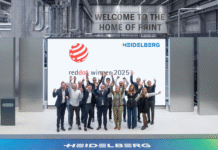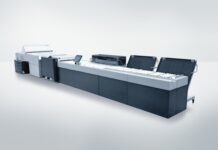
The cold foil process is no newcomer to the industry of glitz and shine; in fact, it’s been around in the rotary, narrow-web industry for quite some time. However, like most technologies, the process has become more stable as the technical know-how, equipment, and materials utilized have become more sophisticated. Advancements in consistency, adhesion, substrate compatibility, and speed have opened doors to a broader range of foil applications across a variety of markets – markets that otherwise may never have considered foil a viable option.
Flexographic machine manufacturers such as Mark Andy, Nilpeter, and Gallus have integrated the cold foil process directly into their flexo printing presses. Beyond the flexographic arena, recent innovations in utilizing the cold foil process with sheetfed lithography are entering the market as an alternative to metallized board. This offset technology utilizes a tacky adhesive that is applied in the first printing head. The foil is then nipped to the adhesive and the carrier stripped away leaving the foil covering the board where required.
Heidelberg has developed this process which has been available in the world market for quite some time now although no such unit was installed in India so far due to various factors that might include price and technological and operational challenges for the printers. However, in a major turnaround, Heidelberg India has announced the first installation in India of the FoilStar on a CD 102 6-color UV combination press with coater at Rave Packaging’s unit in Manesar, Haryana. The 59th installation in the world and India’s first Heidelberg FoilStar press surely demands some introduction.
Heidelberg’s FoilStar explained
In contrast to previous effect foil applications, for which a letterpress or flexographic unit is necessary, FoilStar applies the cold foil using two conventional offset printing units. The first unit prepares images of where the foil is to be applied using the inking unit and an offset printing plate to apply glue either as a spot application or to the entire sheet.
The actual cold foiling mechanism featuring take-up and take-off units for applying the foil is mounted on top of the second print unit. Along with the sheet, the foil is fed into the nip between the blanket and the impression cylinders and applied by pressure to the parts of the printing stock coated with glue. When the backing is removed, the metal layer remains on the sheet.
Subsequent overprinting of the foil enables a great variety of color nuances to be achieved. The flexibility of varying the number (one to six) and width of the foil webs enables foil consumption to be precisely adapted to the current job. Web tension in foil take-up and take-off and the individual reel diameters are automatically recorded by sensors and permanently monitored. A further benefit is that both printing units can be changed over rapidly and are then immediately available for offset printing.
The unique selling points of the FoilStar as described by Heidelberg are its fast changeovers and quick makereadies along with an interface which is operator friendly, a fact which was seconded by Shiv Bhatnagar, COO of Rave Packaging. He said, “Contrary to expectations and speculation, let me make it clear that the FoilStar has a very user friendly operation. We are still not at the optimum level with the machine at this moment both because the press has just been installed and this is a technology which is unique in the country. However, in another two to three months we aim to learn all the ropes and tricks involved and we even plan to organize an Open House in that time-frame to show the technological progress that this machine has brought in.”











